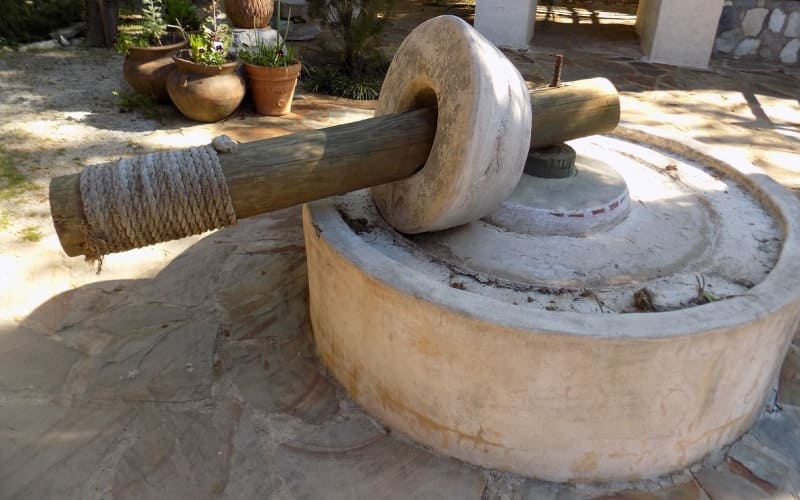
Olive oil: an in-depth look at its history and uses
Olive Oil: History and Uses
Olive oil, with its distinctive flavor and multiple benefits, has deep roots in human history. This ‘liquid gold’ has played a fundamental role in many civilizations, influencing gastronomy, medicine, religion, and even economics.
Ancient civilisations
Olive oil has a fascinating history dating back to ancient civilizations, where it was considered not only a precious food but also a symbol of power, health and divinity.
Mesopotamia and Egypt:
The first evidence of olive oil use in these regions dates back over 5,000 years. In Mesopotamia, cuneiform tablets recorded recipes and rituals that included olive oil. In Egypt, oil was used in various ways:
- Medicine: It was considered a remedy for various diseases and conditions, from simple headaches to complex inflammations.
- Cosmetics: Egyptian women used olive oil as a base for cosmetics and perfumes, appreciating its moisturizing and protective properties.
- Funeral rituals: Olive oil played a role in mummification, helping to preserve and protect bodies for the afterlife.
Ancient Greece:
Theolive tree was sacred in Greece, and its importance was deeply rooted in mythology and culture. According to legend, it was the goddess Athena who gave the olive tree to the city of Athens, granting it prosperity and peace.
- Economy: The production and trade of olive oil was central to the Greek economy. The oil was exported all over the Mediterranean in sealed amphorae.
- Sports: Olympic athletes anointed their bodies with olive oil to protect their skin and improve their performance.
- Religion: Olive oil was used in religious ceremonies, offered to the gods and used to fuel lamps in temples.
Roman Empire:
The Romans inherited and expanded the olive oil culture from Greece. As the Empire expanded, olive oil became a key commodity.
- Agriculture: The Romans perfected olive growing techniques, introducing selected varieties and improving harvesting and production methods.
- Gastronomy: Olive oil was an essential ingredient in Roman cuisine, used in a wide range of dishes, from simple salads to complex stews.
- Engineering: The Romans developed complex presses for oil extraction, increasing the efficiency and quality of production.
Overall, in ancient civilizations, olive oil was more than just food: it was a symbol of life, prosperity, and connection to the divine.
Middle Ages

The Middle Ages, often described as a period of obscurantism between the fall of the Western Roman Empire and the Renaissance, was in fact a time of considerable change and development, and olive oil was no different in this context.
Production and trade:
With the fall of the Roman Empire, many of the large olive plantations were abandoned or destroyed due to barbarian invasions. However, in the Mediterranean regions, particularly in Spain, Italy and Greece, olive oil production continued, albeit on a small scale.
- Monasteries: Monks became the main custodians of olive oil production during the Middle Ages. Many monasteries had vast olive groves and oil presses. The oil produced was used for lighting, cooking, and as a trade commodity.
- Trade routes: Italian city-states such as Venice and Genoa became trading powers, and olive oil was a major commodity. These cities established trade routes across the Mediterranean, bringing olive oil to northern Europe and the Middle East.
Religious use:
Olive oil retained its religious significance during the Middle Ages. It was used in the Church for various sacraments and rituals.
- Anointing: Olive oil was consecrated and used for anointing during baptisms, confirmations, and priestly ordinations.
- Lamps: Olive oil powered the lamps in churches, symbolizing the light of Christ.
Medicine and alchemy:
The Middle Ages saw a renewed interest in medicine and science, and olive oil was the focus of many preparations.
- Medicine: Medieval physicians, based on the writings of Galen and Hippocrates, prescribed olive oil for a range of ailments, from digestive disorders to external wounds.
- Alchemy: Alchemists, forerunners of modern chemists, used olive oil in various preparations and distillations, trying to transform it or extract valuable substances from it.
Cooking:
The medieval diet was strongly influenced by the local availability of ingredients. In the Mediterranean regions, olive oil remained a key ingredient, used for cooking, preserving foods such as fish, and as a dressing for salads and stews.
3. Renaissance and beyond
The Renaissance, a period of cultural and intellectual renaissance that originated in Italy in the 14th century, led to profound transformations in art, science, politics, and economics. Olive oil, with its long history and importance in the Mediterranean, was not immune to these changes.
Production and innovation:
- Advanced techniques: During the Renaissance, there was a renewed interest in agriculture and production techniques. Agronomists and botanists studied and documented olive tree varieties, cultivation methods, and oil extraction techniques, leading to significant improvements in the quality and quantity of the oil produced.
- Expansion of olive groves: The growing demand for olive oil led to an expansion of olive groves, particularly in the Italian regions of Tuscany, Umbria, and Liguria. These regions became famous for their production of high-quality olive oil.
Trade and economy:
- Trade routes: Italian city-states, particularly Venice, Florence and Genoa, consolidated their dominance over the Mediterranean trade routes. Olive oil was a major export commodity, reaching markets as far afield as Northern Europe, North Africa, and the Middle East.
- Merchants and bankers: Families such as the Medici of Florence became powerful by trading in goods, including olive oil. These families invested their earnings in art, culture, and science, further fuelling the Renaissance.
Art and culture:
- Artistic representations: The olive tree and olive oil were often depicted in Renaissance works of art, symbolizing peace, prosperity, and divinity. Artists such as Leonardo da Vinci and Michelangelo incorporated these symbols in their works.
- Use in painting: Olive oil was also used as a medium in some forms of painting, although linseed oil was more common in oil painting.
Science and medicine:
- Botanical studies: The Renaissance was a period of great interest in botany. Olive trees were studied and classified, and their medicinal properties were examined in detail.
- Pharmacopoeia: Olive oil continued to be a key ingredient in many medicinal preparations, and its importance in traditional medicine was reinforced by discoveries and applications.
Uses
1. Cooking
- Antiquity: It was a key ingredient in the Mediterranean diet, used in salads, for cooking, and as a condiment.
- Modern Cuisine: Olive oil is celebrated for its culinary qualities, being a key ingredient in many recipes, from salads to main dishes.
2. Medicine
- Ancient treatments: It was used to treat a variety of illnesses, from wounds to skin diseases. Hippocrates, the father of medicine, called it ‘the great healer’.
- Modern use: Today, olive oil is recognized for its cardiovascular, anti-inflammatory, and antioxidant benefits.
3. Cosmetics and body care
- Antiquity: It was used as a base for perfumes, ointments, and lotions. It was also a key component in ritual baths.
- Modern products: Olive oil is present in many skin and hair care products due to its moisturizing and nourishing properties.
4. Religion and rituals
Olive oil has always had a deep religious and spiritual significance in many cultures and traditions. Its presence in rites and ceremonies not only symbolised divinity and sacredness but also life, protection, and purification.
Antiquity:
- Judaism: Olive oil plays a central role in many Jewish practices and rituals. It was used to anoint kings and priests and to power the Menorah, the seven-armed candelabra in the Temple in Jerusalem. The festival of Hanukkah also known as the Festival of Lights, which celebrates the miracle of the oil, recalls an episode in which olive oil lasted eight days instead of one.
- Christianity: Olive oil has been used since the early days of Christianity for various sacraments and rituals. Anointing with consecrated oil, or chrism, is still a central practice in sacraments such as baptism, confirmation, and priestly ordination.
- Pagan cultures: In ancient Greek and Roman cultures, olive oil was often offered to the gods as a sign of devotion and gratitude. It was also used in rituals of purification and protection.
Middle Ages:
- Christian Church: During the Middle Ages, olive oil continued to play a central role in Christian rituals. Churches often had dedicated olive groves to provide oil for lamps and sacraments. The consecrated oil was considered a powerful symbol of light, protection, and divine grace.
- Islam: Olive oil is mentioned in various passages of the Qur’an and is considered blessed. Although it is not used in specific rituals as in Judaism or Christianity, it is highly respected for its spiritual and therapeutic benefits.
Renaissance and beyond:
- Symbolism: With the rise of humanistic thought and renewed interest in antiquity, olive oil and the olive tree became popular symbols in art and literature. They often represented peace, wisdom, and resurrection.
- Popular practices: Besides the official rites of the great religions, olive oil was often used in popular practices and rituals. It was considered to protect against the evil eye, heal diseases, and bless homes.
Conclusion
Olive oil has spanned millennia, evolving and adapting to different cultures and eras. What has remained constant, however, is its inestimable value for health, beauty, and spirituality. This ‘liquid gold’ continues to be a treasure of the Mediterranean, celebrated and appreciated all over the world.

